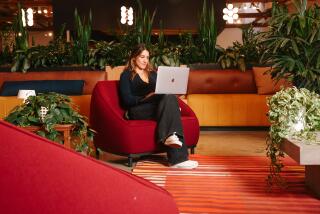Germs are working overtime at the office
- Share via
With more and more workers gulping down coffee and lunch -- sometimes even dinner -- at their keyboards, tens of thousands of germs can be found in nearly every corner of the office. They are lurking beneath the papers and files, on top of keyboards and computer mice and on telephones.
One study found that the office desk has more bacteria on it than the average toilet.
“The biggest revelation is that there is the awareness from the worker that office cleanliness is maybe not where it should be,” said Gary Bauer, vice president of business services for janitorial services company ServiceMaster Clean. “People are eating at their desks. People are working late. There’s probably more personal workspace sharing.”
And workspaces aren’t getting cleaned as frequently as in the past thanks to cost-cutting measures, Bauer said.
Germs can be passed in ways workers may not even think of: shaking hands; touching doorknobs; sharing fax machines, phones and computers. Desks can be a breeding ground for germs, experts said.
Many workers grabbing a sandwich at their desks are not wiping the surfaces down before they lunch, according to the Soap and Detergent Assn. in Washington. The association’s 2004 Clean Hands Report Card also found that 32% of respondents don’t always wash their hands before eating lunch.
“When we’re at home, we tend not to eat on dirty plates, so why would we eat on dirty surfaces at work?” said Brian Sansoni, vice president of communication and membership for the Soap and Detergent Assn., which represents more than 100 manufacturers of cleaning products.
A survey of 1,000 office workers by ServiceMaster Clean found that 85% eat at their desks, 45% have seen colleagues leave the bathroom without washing their hands, 22% see a colleague sneeze, cough or yawn without covering his mouth every day, and more than half felt there was a connection between a clean office and the number of times workers call in sick.
Cold or flu germs can last up to three days on surfaces, said Charles Gerba, a professor of environmental microbiology at the University of Arizona who studies the ways diseases are transmitted. Even though a sick colleague is home in bed, he has laid a “minefield of germs” for his co-workers, Gerba said.
Studies in schools have found that using sanitizers or washing hands can reduce absenteeism by 30% to 50%. No such study has been done in offices, Gerba said.
The average worker touches 30 surfaces a minute, from computer keyboard to mouse to telephone. The average desk harbors 400 times the bacteria of the average toilet, according to a 2002 study Gerba did for Clorox Co., the maker of cleaning products, that measured bacteria levels in offices.
Gerba recommends using hand sanitizers or alcohol gels or sprays and wiping down the desk daily with a disinfecting cleanser to promote office hygiene. Otherwise, throughout the workday, bacteria on desks just keep on growing. “You end up with a bacteria cafeteria,” Gerba said, “basically on your desk.”





